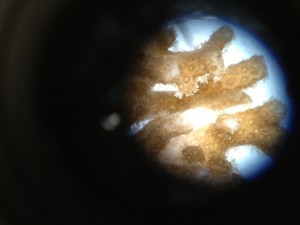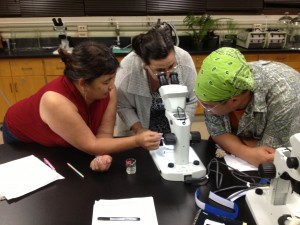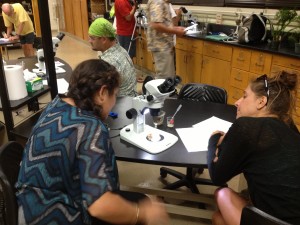
On the Diamond Head beach field trip, everybody explores the intertidal zone hoping to bring back some interesting specimens.
Photo: Matthew Silva
In the Hawaiian creation chant known as the Kumulipo, coral is one of the first things born of the primordial darkness. The rest of creation follows.
Biology (Biol) 197D, a new three-credit lab course being offered at KapCC, sheds light on the coral, the darkness, and Hawai‘i’s scientific and cultural connections with the sea. In this class, students compare traditional Hawaiian teaching methods to western techniques, learn how to talk to different audiences about scientific concepts, and learn more about Hawai‘i’s cultural and scientific connections with the surrounding seas.
The class was possible through a partnership with COSEE, the Centers for Ocean Sciences Education Excellence. COSEE is a program funded by the National Science Foundation. Hawai‘i’s own version, COSEE Island Earth modified the course to fit Hawai‘i’s unique cultural, biological and scientific context. On the syllabus, the course content is billed as a “blending of traditional knowledge and western science.”
Some of the many activities students have participated in included: feeding a sea anemone, a night field trip to Diamond Head beach to search for organisms in tide pools, observing coral and plankton underneath a microscope.
Guest speakers also come in to lecture from time to time, lecturing on topics like native Hawaiian tools and materials, or the threats endangered monk seals face.
The two regular instructors of the course, Mackenzie Manning and Carlie Wiener, hope that Biol 197D will pave the way for KapCC’s own Marine Option Program.
The Marine Option Program is an educational program offered at all other UH campuses that culminates in a certificate of achievement.
In the program, students take nine to 12 credits of marine-related coursework and complete a skills project. The certificate signifies special interest in marine resources or marine biology. Biol 197D is supposed to be the first of these classes offered at KapCC. According to Manning, the Marine Options Program certificate is widely recognized within Hawai‘i’s marine community, which includes people working for NOAA, the U.S. Fish and Wildlife Service, and Hawai‘i’s Department of Land and Natural Resources.
In addition to teaching Biol 197D, Manning teaches Biol 171, 172, Zool 200, and their respective labs. Biol 171 and 172 are general biology courses for biology majors.
Zool 200 is Marine Biology. Of her marine-oriented classes, Manning said,
“I just want people to know that we do have a small albeit developing marine program here at Kapi‘olani Community College.”
She is looking to fill her spring Zool 200 class.
“We go on a lot of really cool field trips, and really explore Hawai’i’s marine ecosystems,” she said.
Field trips include: studying the intertidal zone at Sandy’s, taking a boat out to the Hawai‘i Institute of Marine Biology to discover what kinds of research goes on, hiking and whale watching on the Makapu‘u lighthouse trail, and paddling to Mokauea island to look at Hawai‘i’s last remaining fishing village and study its fishpond.
Wiener is program manager for COSEE, and helped execute the COSEE program here in Hawai’i. COSEE Island Earth is based at the University of Hawai’i in SOEST, or the School of Ocean and Earth Science and Technology. COSEE is also offering a Communicating Ocean Sciences course for informal audiences at Kona to people in the marine tourism industry e.g. scuba diving operators, boat captains, snorkel guides and underwater photographers.
The class came about through conversations between Manning and Wiener. Both had previously worked together at the Hawai’i Institute for Marine Biology.
“(I) began talking about how I want to start a marine options program, and she’s like ‘Well, I want to teach this class. Let’s see how this goes — let’s see what the interest in marine science is here at KCC,” Manning said.
The number of students who signed up for the class was lower than expected, but the instructors see the small class size as a plus.
“The nice thing about having a smaller class is that it’s a lot more intimate and you get to know everybody a lot better.” Weiner said.
In addition to the two regular instructors, the class also benefits from a teaching assistant with a degree in Hawaiian Studies, Pua`ala Pascua. Among her many contributions to the Hawaiian component of the class are a lecture given entirely in Hawaiian, and teaching the class a song about moon phases, with lyrics also entirely in Hawaiian.
“… I knew that KCC had a good science program, so that really pulled me in,” Pascua said, reflecting on her decision to be a teachers assistant for the class. “It fit exactly with what my personal experiences are, being both science and culture oriented…Timing was good.”
When the instructors were asked what their favorite experiences in the class were, Manning and Wiener agreed that one of the highlights was a guest speaker, Mahi Lapierre, who brought native Hawaiian tools and weapons with him for the class to handle.
He also used native plants to impart weaving and knot tying skills. Manning adds “I think the class for me has been a melding of biological science and social science, and so it’s been a really interesting experience to see other ways of instructing that aren’t passive.”
“I think that my favorite course was actually when we went tidepooling. I think the best way to learn about something is to actually experience it…” Pascua said.
Wiener’s favorite part of the course was “getting to know all the students in the class and watching people come out of their shells a little more as the semester goes on”.

Several types of algae found along the intertidal zone were gathered during the intertidal field trip.
Photo: Matthew Silva

Live coral polyps as seen under a microscope. The brown pigmentation comes from photosynthetic algae called zooxanthellae, that lives inside the cells of the polyps.
Photo: Matthew Silva

In this activity, students observe and sketch the structure of both live coral and coral skeletons.
Photo: Matthew Silva

After the coral activity, students feed plankton to sea anemones to observe their reactions and movements.
Photo: Matthew Silva
